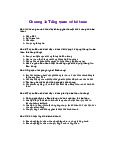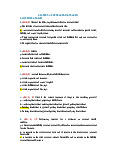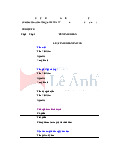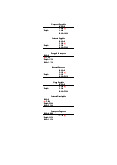




Preview text:
CHAPTER 2. EQUATION ACCOUNTING AND TRANSACTION ANALYSIS I. MULTIPLE CHOICES
1. (LO 3) K Which of the following best describes when an event should be recognized in the accounting records?
a. An event should be recognized in the accounting records if there is a change in assets,
liabilities, or owner’s equity and the change can be measured in monetary terms.
b. An event should be recognized in the accounting records if it involves an interaction
between the company and another external entity.
c. Where there is uncertainty about a future event occurring or not, it should not be recognized.
d. Accountants use tradition to determine which events to recognize.
2. (LO 4) AP As at December 31, at it’s year end, Bruske Company has assets of $12,500;
revenues of $10,000; expenses of $5,500; beginning owner’s capital of $8,000; and drawings
of $1,500. What are the liabilities for Bruske Company as at December 31? a. $1,500 b. $2,500 c. $500 d. $3,500
3. (LO 5) AP Performing services on account will have the following effects on the
components of the basic accounting equation:
a. increase assets and decrease owner’s equity.
b. increase assets and increase owner’s equity.
c. increase assets and increase liabilities.
d. increase liabilities and increase owner’s equity.
4. (LO 5) AP Bing Company pays $700 for store rent for the month. The basic analysis of
this transaction on the accounting records is:
a. the asset Cash is increased by $700 and the expense Rent Expense is increased by $700.
b. the asset Cash is decreased by $700 and the expense Rent Expense is increased by $700.
c. the asset Cash is decreased by $700 and the liability Rent Payable is increased by $700.
d. the asset Cash is increased by $700 and the liability Rent Payable is decreased by $700.
5. (LO 6) C Which of the following statements is true?
a. An income statement presents the revenues, expenses, and changes in owner’s equity for a specific period of time.
b. The income statement shows information as at a specific point in time; the balance sheet
shows information for a specified time period.
c. The statement of cash flows summarizes cash inflows (receipts) and outflows (payments)
as at a specific point in time.
d. The income statement shows information for a specified time period; the balance sheet
shows information as at a specific point in time II. EXERCISES
BE1.7 (LO 1) C Match the following components with the best description below and
indicate if the component is reported on the balance sheet (BS) or income statement (IS). 1. Assets 4. Revenues 2. Liabilities 5. Expenses 3. Owner’s equity 6. Profit Description Component Balance Sheet or Income Statement
a. The increase in assets, or decrease
in liabilities, resulting from business activities Revenues Income Statement carried out to earn profit.
b. Resources controlled by a business that
have the potential to produce economic Assets Balance Sheet benefits.
c. The owner’s claim on the residual assets Owner’s equity Balance Sheet of the company.
d. Present obligations that are expected to
result in an outflow of economic resources Liabilities Balance Sheet
as a result of a past transaction.
e. The cost of resources consumed or services Expenses Income Statement
used in the company’s business activities.
BE1.9 (LO 1) AP Use the accounting equation to answer each of the following questions:
a. The liabilities of Weber Company are $120,000 and the owner’s equity is $232,000. What
is the amount of Weber Company’s total assets?
A = L + OE = 120000 + 232000 = $352,000
b. The total assets of King Company are $190,000 and its owner’s equity is $91,000. What is
the amount of its total liabilities? A = L + OE 190000 = L + 91000 L = $99 000 ,
c. The total assets of Smith Company are $800,000 and its liabilities are equal to one half of
its total assets. What is the amount of Smith Company’s owner’s equity? A = L + OE
800000 = ½ * 800000 + OE OE = $400 000 ,
BE1.10 (LO 1) AP Butler Company is owned by Rachel Butler. The company had total
assets of $850,000 and total liabilities of $550,000 at the beginning of the year. Answer each
of the following independent questions: A = L + OE 850000 = 550000 +OE OE = $ 000 (at the begin) , 300
a. During the year, total assets increased by $130,000 and total liabilities decreased by
$80,000. What is the amount of owner’s equity at the end of the year? A = L + OE
850000 + 1300000 = ( 550000 – 80000 ) + OE OE = $510,000
b. Total liabilities decreased by $95,000 during the year. The company incurred a loss of
$40,000. R. Butler made an additional investment of $100,000 and made no withdrawals.
What is the amount of total assets at the end of the year? A = L + OE
A = 455000 + ( 100000 + 300000 - 40000 )
A = 455000 + 360,000 = $815,000
c. Total assets increased by $45,000 and total liabilities decreased by $50,000. There were no
additional owner’s investments, and R. Butler withdrew $40,000. What is the amount of profit or loss for the year? A = L + OE
( 850000 + 45000 ) = ( 550000 – 50000) + ( OE – 40000 )
OE (at the end) = $435,000 > OE (at the begin) = $300,000 $435,000 - $300,000 = $135,000
The company made a profit for the year .
BE1.12 (LO 2) AP Presented below are eight business transactions. Indicate whether the
transactions increased (+), decreased (-), or had no effect (NE) on each element of the accounting equation.
a. Purchased $250 of supplies on account.
b. Performed $500 of services on account.
c. Paid $300 of operating expenses.
d. Paid $250 cash on account for the supplies purchased in item (a) above.
e. Invested $1,000 cash in the business.
f. Owner withdrew $400 cash.
g. Hired an employee to start working the following month.
h. Received $500 from a customer who had been billed previously in item (b) above.
i. Purchased $450 of equipment in exchange for a note payable.
Use the following format, in which the first one has been done for you as an example: Owner’s Equity Transaction Assets Liabilities Capital Drawings Revenues Expenses a. +$250 +$250 NE NE NE NE b. +$500 c. -$300 -$300 d. -$250 -$250 e. +$1,000 +$1,000 f. -$400 +$400 g. NE NE NE NE NE NE h. +$500 - $500 i. +$450 +$450
BE1.16 (LO 3) AP Prairie Company is owned and operated by Natasha Woods. In
alphabetical order below are the financial statement items for Prairie Company. Using the
appropriate items, prepare an income statement, balance sheet, and statement of owner’s
equity for the month ended October 31, 2021.
N. Woods, capital, October 1, 2021 $36,000 Accounts payable $90,000 N. Woods, drawings $6,000 Accounts receivable $77,500 Rent expense $2,600 Advertising expense $3,600 Service revenue $23,000 Cash $59,300
E1.12 (LO 2) AP At the beginning of March, Brister Software Company had Cash of
$12,000, Accounts Receivable of $18,000, Accounts Payable of $4,000, and G. Brister,
Capital of $26,000. During the month of March, the following transactions occurred:
1. Purchased equipment for $23,000 from Digital Equipment. Paid $3,000 cash and signed a note payable for the balance.
2. Received $12,000 from customers for contracts billed in February.
3. Paid $3,000 for March rent of office space.
4. Paid $2,500 of the amounts owing to suppliers at the beginning of March.
5. Provided software services to Kwon Construction Company for $7,000 cash.
6. Paid BC Hydro $1,000 for energy used in March.
7. G. Brister withdrew $5,000 cash from the business.
8. Paid Digital Equipment $2,100 on account of the note payable issued for the equipment
purchased in transaction 1. Of this, $100 was for interest expense.
9. Hired an employee to start working in April.
10. Incurred advertising expense on account for March, $1,500
Prepare a tabular analysis of the above transactions, as shown in Illustration 1.24 in the text.
The first row contains the amounts the company had at the beginning of March.




